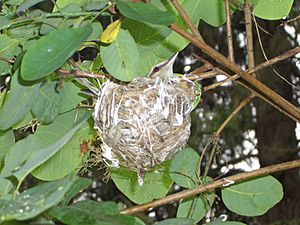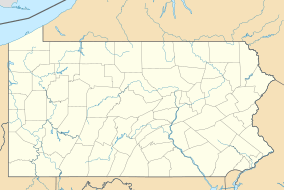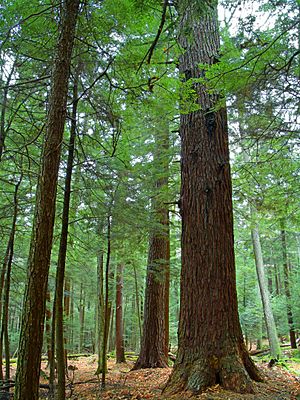Cook Forest State Park facts for kids
Quick facts for kids Cook Forest State Park |
|
|---|---|
|
IUCN Category III (Natural Monument)
|
|

Tom's Run
|
|
| Location | Pennsylvania, United States |
| Area | 8,500 acres (34 km2) |
| Elevation | 1,444 ft (440 m) |
| Established | 1927 |
| Named for | John Cook |
| Visitors | 507,260 |
| Governing body | Pennsylvania Department of Conservation and Natural Resources |
| Website | Cook Forest State Park |
|
Cook Forest State Park Indian Cabin District
|
|
| Lua error in Module:Location_map at line 420: attempt to index field 'wikibase' (a nil value). | |
| Location | Off PA 36 at Cooksburg, Cooksburg, Pennsylvania |
| Area | 6.8 acres (2.8 ha) |
| Built | 1933-1935 |
| Built by | Civilian Conservation Corps |
| MPS | Emergency Conservation Work (ECW) Architecture in Pennsylvania State Parks: 1933-1942, TR |
| NRHP reference No. | 87000019 |
| Significant dates | |
| Added to NRHP | February 12, 1987 |
| Designated: | November 1967 |
Cook Forest State Park is a huge state park in Pennsylvania, USA. It covers about 8,500 acres (34 square kilometers). You can find it in Clarion, Forest, and Jefferson counties.
The park is just south of the Allegheny National Forest. It's a very wooded area with rolling hills and mountains. The Clarion River flows through this beautiful region. Cook Forest State Park is famous for its amazing old-growth white pine and hemlock trees. People used to call it the "Black Forest" because of all the evergreen trees.
Today, Cook Forest is a special place called a National Natural Landmark. National Geographic Traveler magazine even named it one of America's top 50 state parks! The Pennsylvania Department of Conservation and Natural Resources also picked it as one of "25 Must-See Pennsylvania State Parks."
Contents
Park History: From Seneca to State Park
When European settlers first arrived, the Seneca Nation of the Iroquois Confederacy lived here. They used this land for hunting. Later, the English bought the land that became Cook Forest.
Seneca Rock in the park is still named after the first inhabitants. A famous movie, "Unconquered," was filmed here in 1946. It starred Gary Cooper and Paulette Goddard.
The Cook Family's Story
John Cook was the first American settler to live here permanently. He came in 1826 to see if a canal could be built along the Clarion River. In 1828, John bought 765 acres (3.1 square kilometers) and settled with his wife and ten children.
John built his cabin and sawmills near Tom's Run. He worked hard, logging with oxen and floating logs down to Pittsburgh. His son, Andrew, took over the land after John died in 1858. Andrew expanded the family business.
Andrew built more sawmills, a flour mill, and even a hotel called the Cook Forest Inn. He also served as a judge and a bank president. The Cook family descendants still live in some homes along River Road today.
The Forest Cathedral: Saving Ancient Trees
Major Israel McCreight was a key person in saving Cook Forest. He helped make it the first Pennsylvania State Park created to protect a natural landmark. Cook Forest has the most important area of old-growth trees in Pennsylvania. It's unmatched in size east of the Rocky Mountains.
The park is known for its tall white pines and hemlocks. Major McCreight first visited the "Forest Cathedral" in 1910. He was amazed by the giant trees. He felt it was a "crime" to destroy such a beautiful place. He decided it "must be saved for humanity's sake."
How the Park Was Saved
Major McCreight started a campaign to save the forest. In 1910, he and others formed the Pennsylvania Conservation Association. They worked to convince the government to make Cook Forest a state park. For 16 years, they tried to pass laws to buy the land.
In 1923, the Cook Forest Association was created. They wanted to buy the virgin white pine and hemlock forest. Groups across the country and Governor Gifford Pinchot supported them. The Association raised $200,000.
On April 14, 1927, Governor John Stuchell Fisher signed a bill. It set aside $450,000 for the park. But only if the Cook Forest Association raised another $200,000. They did it! On December 28, 1928, the park was officially bought.
The Association's money helped the state buy 6,055 acres (24.5 square kilometers) from A. Cook Sons Company. This made Cook Forest the first Pennsylvania State Park bought to protect a natural landmark.
Park Features and Historic Cabins
A firetower was built in 1929 to spot forest fires. It's over 80 feet (24 meters) tall. You can still climb to the top for amazing views! Sometimes a park guide will open the very top section for visitors.
The Cook Forest State Park Indian Cabin District is a historic area. It has 11 old log cabins. These cabins are behind the park office, along Toms Run. The Civilian Conservation Corps built them between 1933 and 1935. They used American chestnut logs because they resist rot.
Ecology: Home to Giant Trees
Cook Forest is part of the Allegheny Highlands forests region. It's famous for its incredible old-growth Eastern White Pine and Eastern Hemlock trees. Many of these trees are over 150 feet (46 meters) tall! The "Forest Cathedral" has more white pines over this height than anywhere else in the northeastern United States.
Many of these ancient trees started growing after a drought and fire in 1644. The park has about 1,500 to 2,000 acres (6 to 8 square kilometers) of old-growth forests. Besides white pine and hemlock, you can also find old Northern Red Oak, White Oak, Black Cherry, Red Maple, Sugar Maple, American Beech, White Ash, Yellow Birch, Black Birch, and Cucumber Magnolia trees.
Recreation: Fun Things to Do
Cook Forest offers many ways to enjoy nature.
Hiking and Biking
The park has 27 marked trails for hiking, totaling about 29 miles (47 kilometers). The trails go through rolling hills and cool valleys. You can explore the old-growth forest, visit the Fire Tower/Seneca Point, and walk along the Clarion River. Some trees in the "Forest Cathedral" are over 180 feet (55 meters) tall!
Part of the Baker Trail (140 miles / 225 kilometers) and the North Country National Scenic Trail go through Cook Forest. The Baker Trail runs from Freeport to the Allegheny National Forest. The North Country Trail is a very long trail connecting North Dakota to New York.
You can ride bikes on all one-way dirt roads in the park. Biking is not allowed on hiking trails, except for a part of the Heffern Run Trail. If you are under 12, you must wear a helmet when biking. If you ride at night, your bike needs a light. The park has an 11.5-mile (18.5 kilometers) Bicycle Route. It follows quiet roads and trails. You can get a map at the park office.
Swimming and Boating
The park's swimming pool is closed. But you can swim in the Clarion River across from the ranger station. Many local businesses rent canoes and tubes. You can float down the shallow, slow-moving river.
Horseback Riding
There are 4.5 miles (7.2 kilometers) of trails for horseback riding. These are off Cemetery Road and parts of Brown's Run Trail. Several stables nearby offer horseback riding to the public. These include Silver Stallion, Pine Crest, and the Cook Forest Scenic Trailride, Dude Ranch, and Campground.
Hunting and Fishing
About 5,000 acres (20 square kilometers) of the park are open for hunting, trapping, and dog training during certain seasons. You might see deer, wild turkey, bear, and squirrel. Hunting woodchucks is not allowed. Check with the park office for rules and accessible hunting information.
The Clarion River is great for fishing. You can catch trout, warm-water game fish, and panfish. Many people enjoy canoeing or kayaking on the river. About 2.5 miles (4 kilometers) of Tom's Run are stocked with trout. There's also a special fishing pond by the park office. It's for children 12 and younger, and people with disabilities. This pond has a grassy bank for easy access.
Education: Learn About Nature
The park offers programs for all ages from March to December. You can join hands-on activities, guided walks, and evening programs. These help you learn about nature and history.
Schools and youth groups can join special environmental education programs. Teachers can also attend workshops. Make sure to schedule group programs in advance by calling the park office.
You can get a weekly schedule of activities at the park office. The park has an environmental learning center in the Log Cabin Inn. It's in the Main Picnic Area. The Historical Room shows old logging and rafting tools and artifacts.
The fire tower is open for climbing during the day. Sometimes a ranger opens the top booth for visitors. Ask at the park office for the schedule.

A local non-profit craft group is in the historic sawmill. They show traditional crafts, have a gift shop, and offer classes. You can see demonstrations and take classes on different crafts in the summer and fall. The Verna Leith Sawmill Theater has 180 seats. It hosts plays, musicals, and other shows during the summer.
Accommodations: Stay in the Park
You can rent one of the 24 rustic cabins from April to December. These cabins are simply furnished. They have beds, mattresses, a gas stove, a refrigerator, and tables and chairs. You need to bring your own bedding, cooking gear, and dishes. No alcoholic drinks or pets are allowed in the cabins.
There are two cabin areas:
- River Cabins: These are on a hillside overlooking the Clarion River. Two cabins have one room and sleep four people. The other 11 River Cabins have four rooms, a fireplace, and sleep six or eight people.
- Indian Cabins: These smaller, one-room cabins are along Tom's Run, behind the park office. They sleep four people.
Part of Ridge Campground is open all year. Modern restrooms with showers are available from late May to early October. The campground has 226 tent and trailer campsites. Each site has a picnic table and a fire ring. Six sites are accessible for people with disabilities. There's also a dump station and laundry facilities.
Nearby State Parks
Here are some other state parks within 30 miles (48 kilometers) of Cook Forest State Park:
- Chapman State Park (Warren County)
- Clear Creek State Park (Jefferson County)
- Oil Creek State Park (Venango County)
Images for kids





